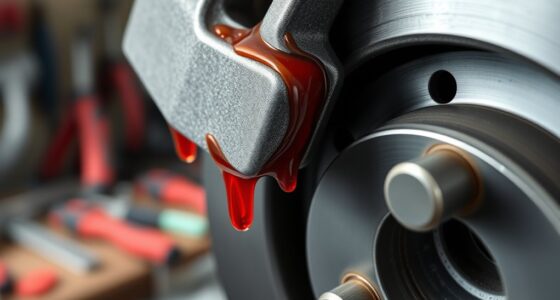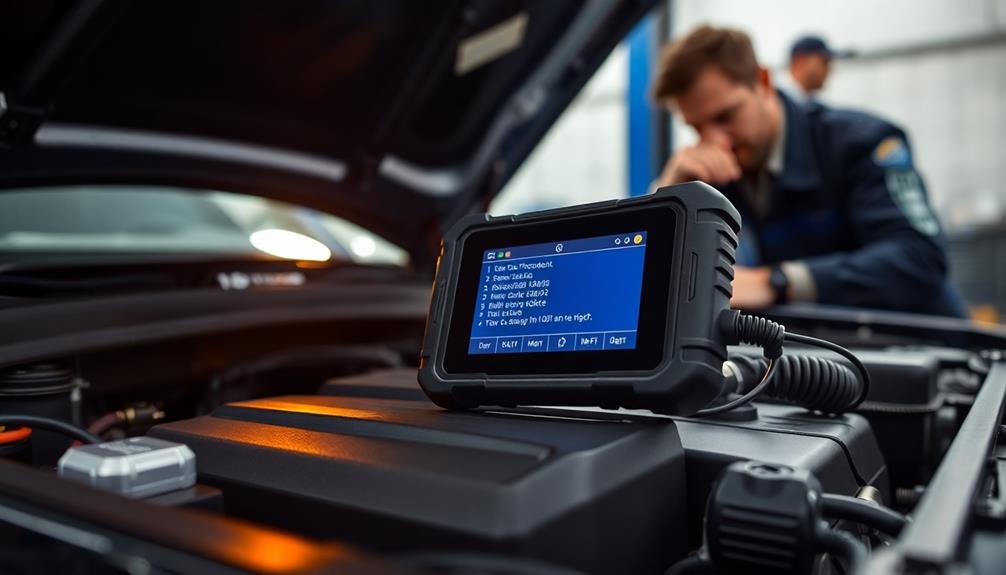If you're stuck using a basic OBD scanner, it's time to toss it aside and invest in an advanced diagnostic tool. These superior tools give you access to critical vehicle systems, allowing for precise diagnostics and efficient repairs. You'll avoid costly misdiagnoses and save money by addressing root causes instead of replacing non-faulty parts. With features like bidirectional control and live data monitoring, you'll gain insights that can enhance your DIY skills considerably. Trust me, making this switch could save you thousands over time, so stick around to discover the best options for your vehicle repair needs.
Key Takeaways
- Advanced diagnostic tools provide comprehensive access to all vehicle systems, ensuring accurate issue identification beyond just reading error codes.
- Bidirectional control features enable efficient programming and resets, streamlining complex repairs and reducing reliance on professional services.
- OEM-level programming reveals extensive diagnostic capabilities, saving time and money by addressing root causes of vehicle issues directly.
- Investing in high-quality diagnostic tools can eliminate unnecessary repairs, protecting you from costly misdiagnoses.
- Enhanced real-time data monitoring improves DIY efficiency, allowing for quicker troubleshooting and significant savings on repair shop fees.
Limitations of OBD Scanners
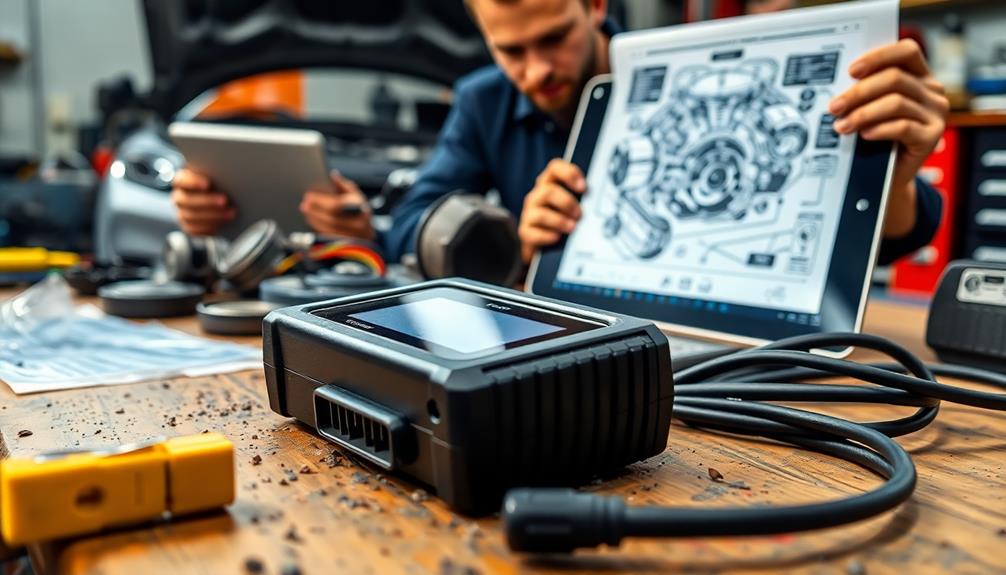
While OBD-II scanners can be useful tools for basic vehicle diagnostics, they come with significant limitations that can hinder your ability to troubleshoot effectively. Many entry-level OBD scanners focus primarily on reading and erasing trouble codes, which means they often miss underlying issues. This narrow focus can lead to misdiagnoses, as these scanners usually access only engine and transmission codes, ignoring vital systems like SRS or TPMS.
You might also run into limitations of OBD scanners regarding bidirectional control. Without advanced functionality, you won't be able to perform essential tasks like programming keys or resetting specific system parameters. These capabilities are essential for thorough diagnostics, and without them, you risk overlooking important problems.
Additionally, OBD-II scanners can provide false readings or fail to detect issues like system vacuum problems, leading to unnecessary repairs. If you want to understand what's really going on with your vehicle, relying solely on an OBD-II scanner won't cut it.
Upgrading to higher-end diagnostic tools that offer OEM-level programming and vehicle-specific diagnostics will save you time and money in the long run.
Benefits of Professional Diagnostic Tools
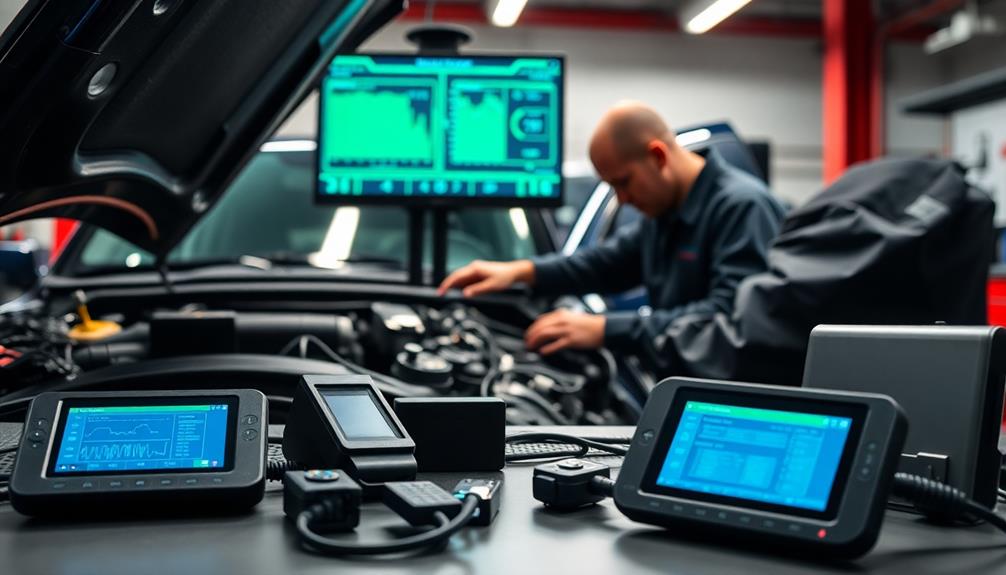
Professional diagnostic tools offer a wealth of benefits that can greatly enhance your vehicle troubleshooting capabilities. Unlike standard OBD-II scanners, which primarily focus on engine and transmission codes, these advanced tools provide thorough access to nearly all vehicle systems. You'll know you're getting a detailed diagnostic that goes beyond basic error codes.
One of the key advantages is the ability to perform OEM-level programming and advanced functions like bidirectional control. This means you can tackle complex repairs and resets, such as TPMS and key programming, that basic scanners simply can't handle.
You need to know that investing in professional diagnostic tools can lead to significant long-term savings, reducing the time spent on diagnostics and repairs.
Additionally, many of these tools come with extensive functionality, including system scans, live data monitoring, and freeze frame data retrieval. This enhances your ability to diagnose and resolve issues effectively.
Plus, advanced diagnostic tools often include valuable customer support and resources, ensuring you can utilize them to their full potential. With these benefits, you'll not only enhance your diagnostic capabilities but also improve customer satisfaction and encourage repeat business.
Key Features to Look For
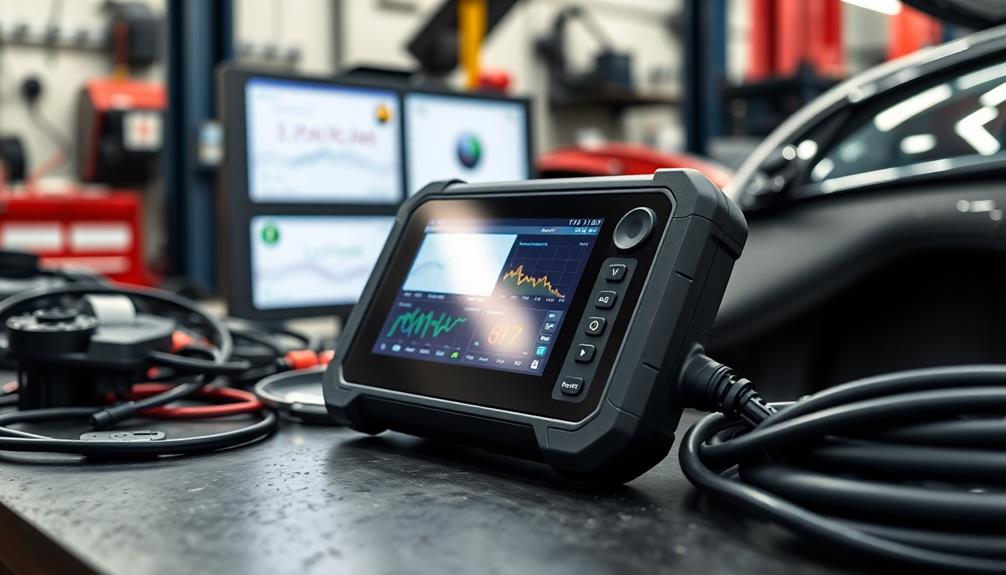
When choosing a diagnostic tool, several key features can make a notable difference in your vehicle troubleshooting capabilities. First, opt for a tool that offers extensive vehicle system access, including critical systems like SRS and TPMS. This guarantees you can troubleshoot a wide range of issues beyond just engine codes, giving you a more complete picture of your vehicle's health.
Additionally, understanding the importance of efficient systems, such as those found in heat pumps, can provide insights into the energy management aspects of vehicle diagnostics.
Look for diagnostic tools with bidirectional control capabilities, enabling vehicle-specific programming and resets. This feature enhances your ability to perform complex diagnostic tasks efficiently.
Additionally, consider tools with OEM-level programming features, essential for deep-level diagnostics and repairs, particularly with modern vehicles.
Don't overlook the importance of live data capabilities. Tools that provide real-time monitoring of vehicle performance metrics allow you to quickly identify and address potential issues as they arise.
Finally, evaluate the user experience and the support resources available for the tool. These factors greatly impact your effectiveness in utilizing the diagnostic equipment in real-world scenarios, guaranteeing you get the most out of your investment.
Make these features a priority, and you'll enhance your vehicle troubleshooting skills tremendously.
Cost-Saving Potential Explained

Switching to advanced diagnostic tools can considerably cut down your expenses on diagnostic equipment.
By eliminating unnecessary repairs and enhancing your DIY efficiency, you'll not only save money but also gain confidence in tackling maintenance tasks.
Investing wisely in the right tools pays off in the long run by keeping your vehicle in top shape without breaking the bank.
Reduced Diagnostic Tool Expenses
Investing in a mid-level OBD scanner can drastically cut your diagnostic tool expenses. Priced between $100 and $350, these scanners give you access to nearly all vehicle systems, considerably reducing the need for pricey professional diagnostics.
Instead of shelling out for multiple expensive tools, consider advanced diagnostic tools that can replace them, which may also contribute to your overall budget management strategy, ultimately saving you thousands.
When you choose quality code readers and mid-level scanners with live data capabilities, you can spot and tackle issues before they become major problems. This proactive approach prevents costly repairs down the line, making your investment worthwhile.
Plus, high-quality diagnostic tools have great longevity and resale value, allowing you to recoup some of your initial investment when you decide to upgrade.
Eliminate Unnecessary Repairs
Choosing the right diagnostic tool can help you eliminate unnecessary repairs and save money in the long run. Many OBD-II scanners only read and erase codes, leading you to overlook the root cause of issues. By investing in a more advanced scan tool, you can gain thorough access to your vehicle's systems, allowing you to pinpoint problems accurately. This approach mirrors the principles of effective fixing technical SEO errors, where understanding the underlying issues is vital for peak performance.
This means you can avoid costly misdiagnoses that result in replacing parts that aren't actually faulty. With professional diagnostic programs, you can save hundreds or even thousands in repair costs. Plus, specialized tools enable real-time ECU map editing, which can help prevent error codes and the repairs tied to them.
If you're a DIY enthusiast, utilizing community-supported tuning strategies can also lower repair costs considerably. You might find solutions that allow you to resolve issues without needing professional help.
Additionally, higher-end diagnostic tools that offer bidirectional control and OEM-level programming guarantee you get accurate diagnostics. This way, you can eliminate unnecessary repairs and enhance your vehicle's performance, keeping your budget intact.
Improve DIY Efficiency
With the right tools at your fingertips, you can dramatically improve your DIY efficiency and save money on vehicle repairs. By utilizing advanced diagnostic tools that go beyond basic OBD-II scanners, you gain extensive access to your vehicle's systems and real-time data analysis. This not only speeds up troubleshooting but also identifies multiple issues from a single code, eliminating unnecessary part replacements and potentially saving you $100 to $300 per visit to a repair shop.
Investing in mid-level scanners that cover nearly all vehicle systems helps you make informed repairs, reducing diagnostic fees typically ranging from $50 to $150. The bidirectional control features of higher-end tools allow you to perform advanced functions like system resets and component tests, which can save you thousands over time by bypassing expensive professional services.
Additionally, engaging in community forums and tapping into shared knowledge platforms enhances your DIY skills. This further empowers you to tackle repairs confidently and efficiently, minimizing your reliance on external services.
Understanding Advanced Programming

Advanced programming opens up a world of benefits for your vehicle diagnostics, allowing you to perform tasks beyond the capabilities of standard scanners.
By mastering key programming techniques and utilizing essential tools, you'll enhance your ability to diagnose and repair complex issues effectively.
Understanding these advanced features won't only improve your skills but also boost customer satisfaction.
Benefits of Advanced Programming
Many vehicle owners and technicians find that investing in advanced programming tools reveals a range of benefits that standard OBD-II scanners simply can't offer. With OEM-level access, you can dive deeper into vehicle diagnostics, guaranteeing more accurate issue identification and resolution.
These tools provide bidirectional control features, enabling vehicle-specific programming and resets, essential for tasks like TPMS reprogramming and battery testing.
Advanced programming capabilities allow you to modify ECU maps and settings in real-time, which helps optimize vehicle performance and tackle issues that traditional scanners may overlook. By utilizing professional diagnostic programs, you can considerably cut down on troubleshooting time, as they deliver detailed information and freeze frame data retrieval across multiple vehicle systems. This enhances your operational efficiency.
Moreover, investing in advanced programming tools can lead to long-term cost savings. By addressing the root causes of issues more effectively than basic OBD-II scanners, you minimize the need for repeated repairs and diagnostics.
Ultimately, embracing advanced programming not only boosts your diagnostic capabilities but also guarantees that you're making a smart investment in your vehicle's longevity and performance.
Key Programming Techniques
Key programming techniques are vital for any technician looking to master modern vehicle diagnostics. To efficiently handle key programming and other complex tasks, you'll need to utilize advanced diagnostic tools that offer bidirectional control. Here are some key aspects to reflect upon:
- OEM-Level Programming: Many vehicles require specialized software for deep-level repairs, far beyond what standard OBD-II scanners can provide. Investing in professional-grade tools is a must.
- Understanding ECU Protocols: Each vehicle's ECU has unique requirements. Familiarizing yourself with different manufacturers' protocols and security measures is essential for successful key programming.
- Specialized Tools: Advanced programming often necessitates high-end diagnostic tools. While these can be pricey, their extensive functionality is invaluable for thorough diagnostics.
- Vehicle-Specific Procedures: Knowing the specific programming procedures for each vehicle can save you significant time and money, making it far more efficient than relying on basic OBD-II scanners.
Essential Tools Overview
To effectively tackle complex vehicle diagnostics, you'll need a solid understanding of the tools available for advanced programming. Relying solely on standard OBD-II scanners limits your diagnostic capabilities. Instead, investing in advanced programming tools like OEM software and professional-grade scanners is essential. These tools provide thorough vehicle-specific programming and resets, far surpassing basic functions.
| Tool Type | Key Features | Benefits |
|---|---|---|
| OEM Software | Vehicle-specific programming | Accurate diagnostics tailored to models |
| Professional-grade Scanner | Access to SRS, TPMS, etc. | Covers nearly all vehicle systems |
| VITA | Deep-level programming capabilities | Facilitates complex repairs |
| AJ Tool | Advanced diagnostic functions | Guarantees effective OEM requirements |
| Bidirectional Control | TPMS and battery testing | Enhances diagnostic accuracy |
These advanced programming tools not only improve your diagnostic prowess but also maintain longevity and resale value, making them a reliable investment. By using these tools, you'll guarantee that your repairs are precise and effective, ultimately saving you time and money.
Enhancing Vehicle Performance

Enhancing vehicle performance is all about releasing your car's potential through smart modifications and tuning. By focusing on performance modifications, you can achieve remarkable gains, often increasing horsepower by 10-20% with proper ECU tuning.
Here's how you can take your vehicle to the next level:
- Advanced ECU Tuning: Utilize sophisticated strategies to optimize fuel maps and timing for significant performance boosts.
- Specialized Tuning Software: Leverage real-time adjustments to ECU parameters, allowing for higher boost levels while keeping your engine reliable.
- Aftermarket Parts: Integrate high-flow exhaust systems and performance intercoolers to improve airflow and minimize turbo lag, enhancing overall power delivery.
- Professional Tuning: Use flash tuners to eliminate check engine light codes related to performance modifications, ensuring your vehicle operates smoothly without unnecessary alerts.
Community Insights and Feedback

The vibrant online forums for Mitsubishi Eclipse 3G owners serve as a hub for sharing valuable insights and experiences related to vehicle tuning and diagnostics. Here, you'll find community insights that emphasize the importance of advanced diagnostic tools over traditional OBD-II scanners.
Many members advocate for a deeper understanding of these tools to enhance vehicle performance and reliability, reducing the chances of misdiagnosis.
Feedback gathered during product development reveals a strong interest in improving diagnostic accuracy while minimizing unnecessary repairs. Users express concerns about the legal and ethical implications of modifying OBD-II codes, highlighting the need for transparency in the creation of these diagnostic tools.
This conversation fosters an environment where enthusiasts can share strategies that prioritize proper diagnostics, leading to cost-effective tuning solutions.
Comparison of Diagnostic Tools

When choosing a diagnostic tool for your Mitsubishi Eclipse 3G, understanding the differences between available options is essential for effective vehicle maintenance.
With various models on the market, it's crucial to make sure you select the right one for your needs. Here's a comparison of the main types of diagnostic tools:
- Code Readers: Priced around $20-$60, these basic tools let you read and erase engine and transmission codes but lack advanced features like programming.
- Mid-Level Scanners: Ranging from $100 to $350, they can access nearly all vehicle systems and offer features like system scans and freeze frame data, though they provide limited bidirectional control.
- Professional Diagnostic Programs: High-end tools used by professionals, these offer extensive diagnostics and vehicle-specific programming, often at a higher price point.
- Scan Tools: Evolving options like the Autel MS series and Launch compete with professional tools in pricing and features, allowing access to multiple vehicle systems.
Choosing the Right Tool
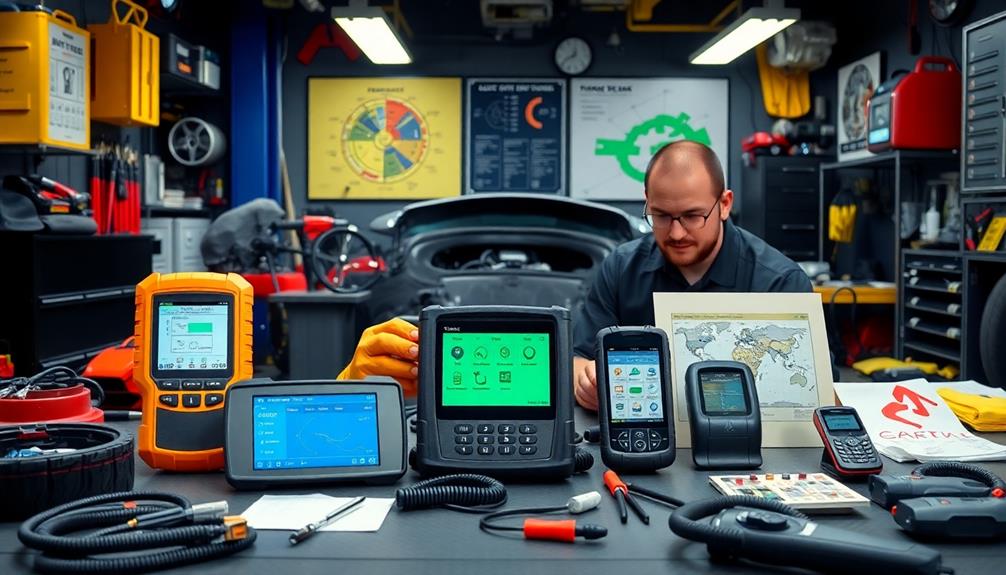
When you're choosing the right diagnostic tool, it's essential to weigh your specific needs against your budget.
Basic code readers might be affordable, but they often lack the advanced features that mid-level or professional tools offer.
Understanding the balance between cost and functionality can help you make a smarter decision for your automotive diagnostics.
Tool Selection Criteria
Selecting the right diagnostic tool involves considering several key factors that align with your needs. By focusing on these tool selection criteria, you can make an informed choice that suits your requirements and budget.
- Functionality: Determine the level of functionality you need. Basic code readers only read and erase codes, while mid-level scanners access multiple vehicle systems for advanced diagnostics.
- Budget: Set a budget that reflects your needs. Entry-level code readers range from $20-$60, mid-range scanners from $100 to $350, and professional tools can exceed $1,000.
- Compatibility: Verify the diagnostic tool is compatible with your vehicle's make and model. Some tools are designed for specific brands, which can enhance diagnostic accuracy.
- Features: Look for advanced features like bidirectional control and OEM-level programming. These capabilities allow for thorough diagnostics, system resets, and component tests.
Cost vs. Functionality
Balancing cost and functionality is essential in choosing the right diagnostic tool for your needs.
You'll want to reflect on how much you're willing to invest while ensuring the tool meets your requirements. Higher-priced professional tools might seem intimidating, but their advanced features—like OEM-level programming—can justify the investment for serious automotive work.
If you're a DIY enthusiast or own a small repair shop, mid-level scanners priced between $100 and $350 can be a smart choice. These mid-level scanners often come with advanced diagnostic features that go beyond basic code reading, offering live data and troubleshooting guidance that can significantly speed up repairs. Unlike a basic $20 scanner replacement tool, which may only provide limited information, mid-level scanners can access a broader range of vehicle systems, helping you accurately diagnose more complex issues. This makes them a valuable investment for those looking to tackle more than just simple fixes.
They provide access to nearly all vehicle systems and diagnostic features, making them cost-effective without sacrificing too much functionality.
On the other hand, code readers, which range from $20 to $60, offer basic capabilities like reading and erasing engine codes, but they may fall short for more complex diagnostics.
Maximizing Your Investment

Maximizing your investment in diagnostic tools is essential for any automotive professional looking to enhance their service offerings and efficiency.
By choosing a high-quality professional diagnostic tool, you can save thousands in repair costs and improve your workflow. Here are some strategies to get the most out of your investment:
- Choose Advanced Features: Invest in tools with bidirectional control and extensive vehicle programming to minimize service times.
- Utilize OEM-Level Tools: These tools give you access to manufacturer-specific diagnostics, reducing costly errors from generic scanners.
- Maintain Resale Value: High-end diagnostic tools often hold their value well, allowing you to recoup a significant portion of your investment when upgrading.
- Engage with Community Resources: Participate in forums and discussions to learn about best practices and tool capabilities, maximizing your return on investment.
Frequently Asked Questions
Will Cheap OBD2 Scanners Work?
Yes, cheap OBD-II scanners can work for basic diagnostics, reading and erasing simple codes. However, they might not provide the advanced features or accuracy needed for more complex vehicle issues, potentially leading to misinterpretation.
How to Clear OBD-II Error Code?
"An ounce of prevention is worth a pound of cure." To clear OBD-II error codes, connect your scanner, turn on the ignition, select "Erase Codes," and test drive afterwards to verify issues are resolved.
What Does OBD Mean on a Car?
OBD stands for On-Board Diagnostics. It's a system that monitors your car's performance and emissions, using sensors to collect data. This helps you identify issues quickly, ensuring your vehicle runs efficiently and stays compliant.
What Is the Difference Between an OBD2 Reader and an OBD2 Scanner?
An OBD-II reader primarily reads and erases trouble codes, while an OBD-II scanner offers deeper diagnostics, accessing multiple vehicle systems. Choosing the right tool enhances your vehicle troubleshooting, saving you time and potential repair costs.
Conclusion
Imagine cruising down the road, worry-free, knowing you've got the best diagnostic tool at your fingertips. By choosing a professional tool over a standard OBD scanner, you're not just saving money; you're revealing a treasure trove of insights about your vehicle. It's like having a personal mechanic in your garage. So, embrace this upgrade, maximize your investment, and drive confidently into the future, leaving the limitations of basic scanners in your rearview mirror.



